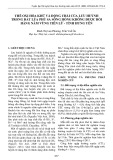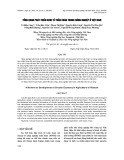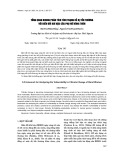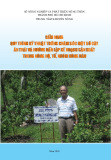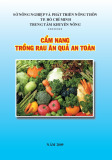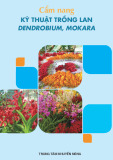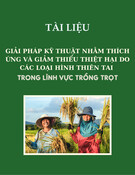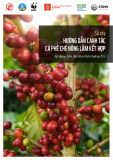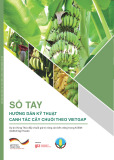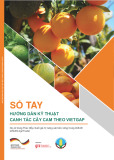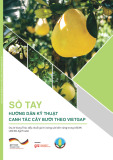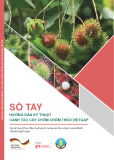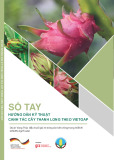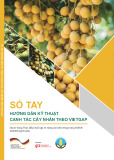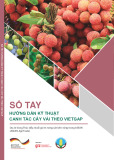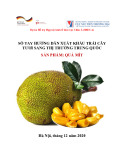
Vietnam J. Agri. Sci. 2025, Vol. 23, No. 2: 143-151 Tạp chí Khoa học Nông nghiệp Việt Nam 2025, 23(2): 143-151
www.vnua.edu.vn
143
-
Thiều Thị Phong Thu*, Giàng A Công
Khoa Nông học, Học viện Nông nghiệp Việt Nam
*Tác giả liên hệ: ttpthu@vnua.edu.vn
Ngày nhận bài: 16.12.2024 Ngày chấp nhận đăng: 24.02.2025
TÓM TẮT
Nghiên cứu được tiến hành nhằm xác định tỷ lệ phối trộn và loại phân ủ sử dụng trong giá thể phù hợp cho sinh
trưởng và năng suất mồng tơi. Thí nghiệm hai nhân tố được bố trí theo kiểu khối ngẫu nhiên đầy đủ với 3 lần nhắc
lại bao gồm loại phân ủ (P1 và P2) và tỷ lệ phối trộn phân ủ trong giá thể (G1 (1 đất : 1 trấu hun : 1 phân ủ);
G2 (1 đất : 1 trấu hun : 2 phân ủ); G3 (1 đất : 1 trấu hun : 3 phân ủ)). Các chỉ tiêu theo dõi bao gồm chiều cao cây,
đường kính thân, chỉ số SPAD, diện tích lá, khối lượng chất khô, năng suất và hàm lượng nitrat. Kết quả cho thấy
tăng tỷ lệ phân ủ P1 hay P2 phối trộn trong giá thể có ảnh hưởng tốt đến các chỉ tiêu sinh trưởng, sinh lý, do đó làm
tăng có ý nghĩa năng suất cá thể của mồng tơi. Hàm lượng nitrat trong cây khi bón phân ủ P1 và P2 ở các tỷ lệ phối
trộn khác nhau đều nằm trong giới hạn cho phép của Bộ Nông nghiệp và Phát triển nông thôn. Như vậy, nên bón
phân ủ P1 và P2 với tỷ lệ giá thể là 1 đất : 1 trấu hun : 3 phân ủ để mồng tơi sinh trưởng tốt, cho năng suất và chất
lượng cao.
Từ khóa: Compost, mồng tơi, nông nghiệp hữu cơ, tỷ lệ phối trộn phân ủ.
Effects of Mixing Ratios and Types of Compost used in Growing Substrate
on the Growth and Yield of Malabar Spinach (Basella alba L.) at Gia Lam - Ha Noi
ABSTRACT
The study was conducted to determine the mixing ratio and type of compost used in the growing substrate
suitable for the growth and yield of Basella alba L. The factorial experiment was arranged in a randomized complete
block design (RCBD) with 3 replications including 6 treatments (P1G1, P1G2, P1G3, P2G1, P2G2, P2G3) of 2 types
of compost (P1 and P2) and 3 mixing ratios of compost in growing substrate (G1 (1 soil : 1 burnt rice husk : 1
compost); G2 (1 soil : 1 burnt rice husk : 2 compost); G3 (1 soil : 1 burnt rice husk : 3 compost)). The monitored
parameters included plant height, stem diameter, SPAD index, leaf area, dry matter weight, yield and nitrate content
in the plant. The results showed that increasing the ratio of compost P1 or P2 mixed in the growing substrate had a
positive effect on the growth and physiological parameters, thereby significantly increasing the individual yield of
malabar spinach. The nitrate contents in plant fertilized with compost P1 and P2 at different mixing ratios were within
the allowable limits of the Ministry of Agriculture and Rural Development. Therefore, compost P1 and P2 should be
fertilized with a substrate ratio of 1 soil: 1 burnt rice husk: 3 compost for better growth, high yield and quality of
malabar spinach.
Keywords: Application rate, Basella alba L., compost, organic agriculture.

Ảnh hưởng của tỷ lệ phối trộn và loại phân ủ sử dụng trong giá thể đến sinh trưởng và năng suất mồng tơi (Basella
alba L.) tại Gia Lâm - Hà Nội
144

Thiều Thị Phong Thu, Giàng A Công
145
–

Ảnh hưởng của tỷ lệ phối trộn và loại phân ủ sử dụng trong giá thể đến sinh trưởng và năng suất mồng tơi (Basella
alba L.) tại Gia Lâm - Hà Nội
146
Yếu tố thí nghiệm CCC (cm) ĐKT (cm) SPAD
17 NST 17 NST 37 NST 17 NST 37 NST
P1 G1 27,32b 0,57c 0,83b 32,25a 35,56b
G2 28,83ab 0,59bc 0,92ab 32,87a 36,07ab
G3 30,60ab 0,69ab 0,95ab 33,60a 38,06ab
P2 G1 29,84ab 0,63abc 0,95ab 32,29a 37,78ab
G2 30,53ab 0,65abc 0,98ab 32,97a 38,37ab
G3 31,57a 0,71a 1,04a 34,16a 38,98a
Loại phân (P) P1 28,91b 0,61b 0,89b 32,90 a 36,56b
P2 30,59a 0,66a 0,99a 33,24a 38,29a
Tỷ lệ bón (G) G1 28,58b 0,59b 0,88b 32,27b 36,67b
G2 29,68ab 0,62b 0,95ab 32,92ab 37,22ab
G3 31,00a 0,70a 0,99a 34,02a 38,39a
Tukey HSD0,05 (P × G) 3,883 0,089 0,197 2,461 2,954
Tukey HSD0,05 (P) 1,441 0,033 0,073 0,913 1,096
Tukey HSD0,05 (G) 2,173 0,050 0,110 1,377 1,653
CV(%) 4,61 4,95 7,37 2,63 2,79

Thiều Thị Phong Thu, Giàng A Công
147
Yếu tố thí nghiệm Diện tích lá (LA)
14 NST 28 NST 42 NST
P1 G1 3,099a 4,551a 5,013b
G2 3,134a 4,940a 5,707ab
G3 3,874a 5,540a 6,513ab
P2 G1 3,135a 4,902a 5,542ab
G2 3,641a 5,047a 6,148ab
G3 4,040a 5,928a 7,141a
Loại phân
(P)
P1 3,36a 5,01a 5,74a
P2 3,58a 5,29a 6,27a
Tỷ lệ bón
(G)
G1 3,07b 4,72b 5,27b
G2 3,38ab 4,99ab 5,92ab
G3 3,95a 5,73a 6,82a
Tukey HSD0,05 (P × G) 1,397 1,409 1,702
Tukey HSD0,05 (P) 0,518 0,532 0,631
Tukey HSD0,05 (G) 0,782 0,789 0,952
CV(%) 14,21 9,67 10,00




![Bài giảng Tiếng Anh chuyên ngành Bảo vệ thực vật [chuẩn nhất]](https://cdn.tailieu.vn/images/document/thumbnail/2025/20250506/vinarutobi/135x160/5631746530031.jpg)

